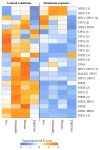Aluminum Responsive Genes in Flax (Linum usitatissimum L.)
- PMID: 30941364
- PMCID: PMC6421055
- DOI: 10.1155/2019/5023125
Aluminum Responsive Genes in Flax (Linum usitatissimum L.)
Abstract
Flax (Linum usitatissimum L.) is a multipurpose crop which is used for the production of textile, oils, composite materials, pharmaceuticals, etc. Soil acidity results in a loss of seed and fiber production of flax, and aluminum toxicity is a major factor that depresses plant growth and development in acid conditions. In the present work, we evaluated gene expression alterations in four flax genotypes with diverse tolerance to aluminum exposure. Using RNA-Seq approach, we revealed genes that are differentially expressed under aluminum stress in resistant (Hermes, TMP1919) and sensitive (Lira, Orshanskiy) cultivars and selectively confirmed the identified alterations using qPCR. To search for differences in response to aluminum between resistant and sensitive genotypes, we developed the scoring that allowed us to suggest the involvement of MADS-box and NAC transcription factors regulating plant growth and development and enzymes participating in cell wall modifications in aluminum tolerance in flax. Using Gene Ontology (GO) enrichment analysis, we revealed that glutathione metabolism, oxidoreductase, and transmembrane transporter activities are the most affected by the studied stress in flax. Thus, we identified genes that are involved in aluminum response in resistant and sensitive genotypes and suggested genes that contribute to flax tolerance to the aluminum stress.
Figures



Similar articles
-
[CAX3 Gene is Involved in Flax Response to High Soil Acidity and Aluminum Exposure].Mol Biol (Mosk). 2018 Jul-Aug;52(4):595-600. doi: 10.1134/S0026898418040195. Mol Biol (Mosk). 2018. PMID: 30113025 Russian.
-
Glutathione S-transferases and UDP-glycosyltransferases Are Involved in Response to Aluminum Stress in Flax.Front Plant Sci. 2016 Dec 21;7:1920. doi: 10.3389/fpls.2016.01920. eCollection 2016. Front Plant Sci. 2016. PMID: 28066475 Free PMC article.
-
miR319, miR390, and miR393 Are Involved in Aluminum Response in Flax (Linum usitatissimum L.).Biomed Res Int. 2017;2017:4975146. doi: 10.1155/2017/4975146. Epub 2017 Feb 19. Biomed Res Int. 2017. PMID: 28299328 Free PMC article.
-
Genome-wide identification of ATP binding cassette (ABC) transporter and heavy metal associated (HMA) gene families in flax (Linum usitatissimum L.).BMC Genomics. 2020 Oct 19;21(1):722. doi: 10.1186/s12864-020-07121-9. BMC Genomics. 2020. PMID: 33076828 Free PMC article. Review.
-
Flax (Linum usitatissimum L.) Fibers for Composite Reinforcement: Exploring the Link Between Plant Growth, Cell Walls Development, and Fiber Properties.Front Plant Sci. 2019 Apr 3;10:411. doi: 10.3389/fpls.2019.00411. eCollection 2019. Front Plant Sci. 2019. PMID: 31001310 Free PMC article. Review.
Cited by
-
GsMAS1 Encoding a MADS-box Transcription Factor Enhances the Tolerance to Aluminum Stress in Arabidopsis thaliana.Int J Mol Sci. 2020 Mar 15;21(6):2004. doi: 10.3390/ijms21062004. Int J Mol Sci. 2020. PMID: 32183485 Free PMC article.
-
Comprehensive RNA-Seq-based study and metabolite profiling to identify genes involved in podophyllotoxin biosynthesis in Linum album Kotschy ex Boiss. (Linaceae).Sci Rep. 2023 Jun 7;13(1):9219. doi: 10.1038/s41598-023-36102-7. Sci Rep. 2023. PMID: 37286620 Free PMC article.
-
Comparative Inter- and IntraSpecies Transcriptomics Revealed Key Differential Pathways Associated With Aluminium Stress Tolerance in Lentil.Front Plant Sci. 2021 Aug 31;12:693630. doi: 10.3389/fpls.2021.693630. eCollection 2021. Front Plant Sci. 2021. PMID: 34531881 Free PMC article.
-
Transcriptome map and genome annotation of flax line 3896.Front Plant Sci. 2025 May 16;16:1520832. doi: 10.3389/fpls.2025.1520832. eCollection 2025. Front Plant Sci. 2025. PMID: 40453339 Free PMC article. No abstract available.
References
-
- Gupta N., Gaurav S. S., Kumar A. Molecular basis of aluminium toxicity in plants: a review. American Journal of Plant Sciences. 2013;4(12):21–37. doi: 10.4236/ajps.2013.412a3004. - DOI
MeSH terms
Substances
LinkOut - more resources
Full Text Sources

